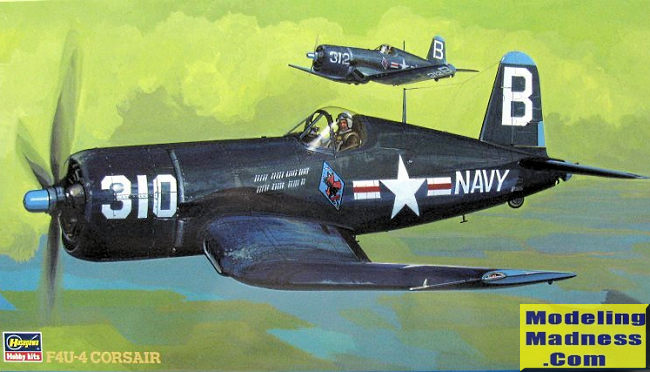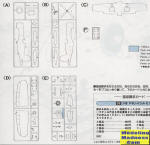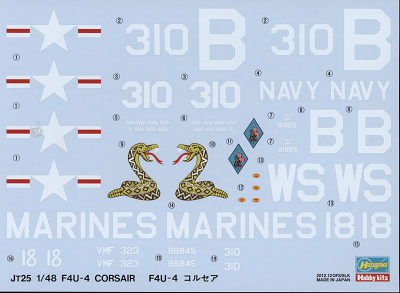
Hasegawa 1/48 F4U-4 Corsair
| KIT #: | 09125 |
| PRICE: | 1500 yen |
| DECALS: | Two options |
| REVIEWER: | Scott Van Aken |
| NOTES: |
|

| HISTORY |
The F4U-4 is the ultimate WWII variant of the Corsair. The -4 introduced a more powerful engine, this time driving a four-bladed prop. It still had many of the same basic airframe parts as the earlier versions, but several of those were beefed up so that the Corsair could handle more ordnance. By the time the -4 entered service during the last year of the war, it was pretty obvious that the days of the specialized naval bomber were numbered. The Corsair was able to carry a heavier payload than the SB2C Helldiver and it did not need the extra crewman. Additionally, it was much faster and if it had to defend itself, it was more than a match for most of the adversaries it had to meet. The Marines loved the bird. It could carry a wide variety of ordnance, was fast, was rugged, and able to operate with ease from either rough strips or aircraft carriers.
Despite the wholesale canceling of contracts that occurred at the end of World War II, the Corsair was one of the few still kept in production, albeit at a much reduced rate. The final -4 rolled off the assembly line in mid 1947, only to be supplanted by even more updated versions. When the Korean War broke out in mid-1950, there were still plenty of F4U-4s in fleet service. They continued to be used with much success in the ground attack mission until the end of the war. Jets may be faster, but the Corsair could carry a respectable load and hang around to suppress enemy troops.
After seeing military service, a number of Corsairs joined the Air Racing circuit and decades later became the prize possessions of a few lucky warbird operators. The last military use of the Corsair was during the 'Soccer War' of 1969 between Honduras and El Salvador. Both countries operated the Corsair against each other, with those of Honduras being credited with a few air to air victories.
| THE KIT |
 A
short time ago, I built the Minicraft boxing of this kit. That kit had some
issues that is normal with kits that had been around a while and I thought I'd
order a relatively fresh example to see how well the molds had held up over the
years, and to see if I had the same problems with brittle plastic that I
discovered with the previous build.
A
short time ago, I built the Minicraft boxing of this kit. That kit had some
issues that is normal with kits that had been around a while and I thought I'd
order a relatively fresh example to see how well the molds had held up over the
years, and to see if I had the same problems with brittle plastic that I
discovered with the previous build.
This is one of several Mania designed kits that were put into Hasegawa's lineup after that company went out of business. In addition to several 1/72 kits, the Ki-27 and the older N1K2-J kits in 1/48 are ex-Mania models. Despite their now being considered geriatric models, these kits hold up extremely well against their more modern counterparts. Detailing is very good, even though it is of the raised panel line variety. This is the Minicraft boxing from the mid 1980s when Minicraft imported Hasegawa kits, supplying their own box and English instructions.
Before this, I had only seen this kit molded in blue and am quite pleased that this one is in medium grey. The cockpit includes a tub with raised detail on the side consoles and instrument panel. It includes a seat and stick with an additional seat cushion; rudder pedals of sorts are molded into the floor. The engine detail is good for its day consisting of the front bank of cylinders on a backing plate. The pushrods are molded on the front crankcase housing.
Landing gear detailing is quite good, though again, not up to modern standards. The wheel wells are a bit shallow for the main gear and non-existent for the tail wheel. There is a pilot figure. Kit includes a two-piece canopy that can be displayed open if you desire. Things under wings are limited to two drop tanks. Any bombs will have to come from the spares box. There is no provision for rockets at all, not even holes in the wings for stub launchers.
 As
befits a kit of this age, there are ejector pin marks on the inside of all the
gear door and on the main landing gear. There are also a number on the cockpit
floor which will be interesting to try to remove. However the rest of the kit is
devoid of flash and the mold seams are quite small.
As
befits a kit of this age, there are ejector pin marks on the inside of all the
gear door and on the main landing gear. There are also a number on the cockpit
floor which will be interesting to try to remove. However the rest of the kit is
devoid of flash and the mold seams are quite small.
| CONCLUSIONS |
Don't let the age of the kit and the raised panel lines deter you from considering this one. Sure, it isn't as well detailed as the Hobby Boss kit, but is considerably less expensive, builds into a superb model for your shelves and you won't go blind attaching and looking in the carpet for small parts.
June 2018
Copyright ModelingMadness.com. All rights reserved.
If you would like your product reviewed fairly and fairly quickly, please contact the editor or see other details in the Note to Contributors.
Back to the Main Page Back to the Review Index Page Back to the Previews Index Page